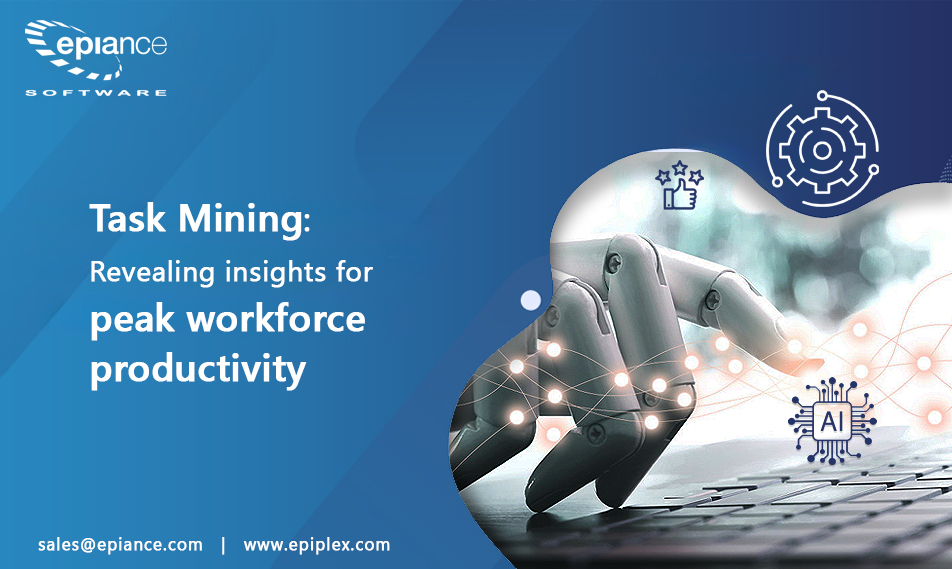
Unleashing Hidden Efficiency: How Task Mining Revolutionizes Workforce Productivity
In the continuously evolving digital landscape, unlocking the full potential of your workforce relies on embracing technological advancements. As organizations transform into distributed entities and adopt various modes of work execution, two critical factors come to the forefront: gaining a deeper understanding of people, processes, and technology, and effectively aligning these elements to foster a cohesive work culture. Let’s explore how task mining can revolutionize workplace productivity.
Why is this increased attention on workforce productivity?
In the current competitive business environment, productivity is the ultimate game-changer. By prioritizing productivity, organizations can create a high-performing and sustainable work environment. That's where task mining comes into play, offering a breakthrough solution for organizations navigating the challenges of hybrid and remote work setups.
A focus on workforce productivity brings numerous benefits, including increased efficiency, competitive advantage, innovation, employee engagement, customer satisfaction, adaptability, and work-life balance. It enables you to precisely gauge productivity levels, even in a hybrid work environment. By identifying areas for improvement, streamlining processes, and guiding automation efforts, task mining becomes your secret weapon for success.
How does task mining boost workforce productivity?
Task mining is not intended as an employee surveillance tool, contrary to certain concerns. Instead, it focuses on individual tasks, providing managers with in-depth insights into team performance, delays, and task variations if any. Capturing and analyzing user interactions with systems sheds light on common actions and enhances process comprehension. Leveraging this data facilitates process improvement, guides automation initiatives, and identifies areas with the highest potential for productivity enhancements.
The 9 benefits of task mining
Task mining offers several advantages for organizations striving to optimize their operations by offering:
1. Unique productivity insights : By analyzing resource and task productivity, task mining goes beyond conventional business metrics. It allows you to identify highly productive users, understand their work patterns, and uncover opportunities for improvement.
2. Automation opportunities : Task mining leverages productivity, performance, and frequency insights to identify areas primed for automation. It streamlines common processes and eliminates unproductive, repetitive tasks, freeing up employees to focus on more valuable responsibilities.
3. Efficiency and cost-effectiveness : Efficiency and cost-effectiveness: Improved productivity allows organizations to accomplish more with the same or fewer resources. By optimizing workflows, eliminating inefficiencies, and streamlining processes, organizations can reduce costs, enhance operational efficiency, and achieve higher profitability.
4. Competitive advantage : A productive workforce gives organizations a competitive edge. When employees are efficient and able to deliver high-quality work promptly, organizations can respond to market demands more effectively, deliver superior products or services, and outperform competitors.
5.Innovation and growth : Productivity gains free up resources, both in terms of time and human capacity. This allows organizations to invest in innovation, research and development, and strategic initiatives. By fostering a culture of productivity, organizations can drive innovation, explore new markets, and fuel growth.
6. Employee engagement and satisfaction : A conducive work environment can enhance employee engagement and job satisfaction. When employees feel that their work is purposeful, efficient, and aligned with organizational goals, they are more likely to be motivated, satisfied, and committed to their roles. This, in turn, can lead to higher employee retention, increased morale, and positive work culture.
7. Flexibility and adaptability : An empowered workforce is more adept at navigating shifts, obstacles, and disruptions. When employees are efficient and adaptable, they can quickly pivot, learn new skills, and respond to evolving business needs. This agility allows organizations to navigate uncertain market conditions and seize opportunities effectively.
8. Customer satisfaction : Workforce productivity directly impacts customer satisfaction. When employees can deliver high-quality products or services promptly, customers are more likely to be satisfied and loyal. Efficient processes, effective communication, and timely responses contribute to a positive customer experience, leading to customer retention and positive word- of-mouth referrals.
9. Work-Life balance : Improving productivity often involves finding ways to work smarter rather than longer. By optimizing processes, eliminating unnecessary tasks, and leveraging technology, organizations can help employees achieve a better work-life balance. This balance promotes employee well-being, reduces burnout, and enhances overall job satisfaction
By combining task mining with process mining and business data analysis, you can drive transformative business outcomes. This holistic approach enables process discovery, conformance checking, root cause analysis, segregation of duties, and performance analysis. It empowers organizations to optimize processes, enhance compliance, and improve overall performance.
Understanding the intersection of people, processes, and data serves as the foundation for genuine business transformation. Task mining empowers organizations to reduce friction in processes, elevate customer service, and accelerate digital transformation by effectively connecting user task data, system logs, and business data.
Getting started with task mining
Embarking on a task-mining initiative requires a few key steps and considerations to be undertaken including clearly defined objectives, planning the technology infrastructure, along with putting together a change management team who will address any potential resistance or concerns from employees, communicate the benefits, involve employees in the process, and provide support to facilitate a smooth transition.
An empowered and engaged workforce is paramount to boosting productivity in the modern digital enterprise. Task mining, with its ability to uncover inefficiencies, optimizes processes, and provides valuable insights, plays a vital role in achieving this objective. By embracing task mining, organizations can transform their operations, enhance customer service, and ensure a seamless transition to a hybrid human-machine workforce. Business transformation begins with understanding the intricate relationship between people, processes, and data.
To know more about task mining, and how to get started, connect with our experts at sales@epiance.com